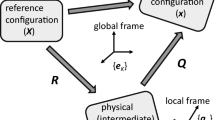Abstract
The fact that the elastic limit of some solids increases with increasing stress rate has been qualitatively and semiquantitatively established for many decades. Well known experimental difficulties have impeded reliable quantitative measurements of the magnitude or, in some solids, even the existence of such an increase of the elastic limit with stress rate.
The present paper describes a simple method for accurately measuring the dynamic elastic limit in any solid which has a linear-elastic domain at small strain, including high-strength structural metal alloys. This method has the advantages of laboratory simplicity, a minimum of complex assumptions, and a close parallel with the manner in which the quasistatic elastic limit generally is determined.
Although it is subsidiary to the main focus of this paper, evidence is presented here that a knowledge of the dynamic elastic limit firmly established by experiment, can be of considerable value for subsequent research in the continuum mechanics of solids, particularly with respect to the existence and properties of two distinct yield surfaces during impact loading.
Similar content being viewed by others
Abbreviations
- V Y :
-
particle velocity at elastic limit
- t c :
-
time of contact
- e :
-
coefficient of restitution
- ν:
-
particle velocity
- V H :
-
initial velocity of hitter specimen
- V o :
-
maximum particle velocity
- L :
-
length of specimen
- σ Y :
-
elastic limit (inner yield surface)
- \(\varrho _o \) :
-
mass density
- E :
-
bar modulus
- c o :
-
bar wave speed
- V f :
-
final struck specimen velocity
- σ:
-
nominal axial stress
- ∈:
-
nominal axial strain
- σ:
-
strain at elastic limit
- ∈ Y :
-
measured parabola coefficient
- σ N :
-
outer yield surface
- ∈ C :
-
strain at the outer yield surface
- K N :
-
measured constant
- C P :
-
plastic wave speed
References
Taylor, G.I., “The Testing of Materials at High Rates of Loading,”J. Inst. Civil Engrs.,26,486–518 (1946). (Also in The Scientific Papers of Sir Geoffrey Ingram Taylor, I: Mechanics of Solids, edited by George K. Batchelor, University Press, Cambridge, England, No. 36, 516–545, 1958).
Hausmaninger, Victor, “Versuch über den Stoss von Kautschukcylindern,”Sitz. ber. Math.-Naturw. Cl. Kaiserl. Akad. Wiss., Wien,88,Part II (1–5),768–781 (1884), (See Ref. 7, Section 3.35).
Hamburger, Max, “Untersuchung über die Zeitdauer des Stosses von Cylindern und Kugeln,”Annalen der Physik und Chemie, Neue Folge,28,653–665 (1886). (See Ref. 7, Section 3.35.)
Sears, J.E., “On the Longitudinal Impact of Metal Rods with Rounded Ends: Part II,”Trans. Cambridge Phil. Soc.,21,49–105 (1912). (See Ref. 7, Section 3.35.)
Bell, James F., “An Experimental Study of the Unloading Phenomenon in Constant Velocity Impact,”J. Mech. Phys. Solids,9,1–15 (1961).
Bell, James F., “Experimental Study of the Interrelation between the Theory of Dislocations in Polycrystalline Media and Finite Amplitude Wave Propagation in Solids,”J. Appl. Phys.,32 (10),1982–1993 (Oct.1961).
Bell, James F., “The Experimental Foundations of Solid Mechanics,”Handbuch der Physik,VIa/1,1–813,Springer-Verlag (1973).
Bell, James F., “Diffraction Grating Strain Gauge,”Proc. of SESA,17 (2),51–64 (1960).
Schneebeli, Heinrich, “Ueber den Stoss elastischer Körper und eine numerische Bestimmung der Stosszeit,”Annalen der Physik und Chemie, Poggendorff,143,239–250 (1871).
Boltzmann, Ludwig, “Einige Experimente über den Stoss von Cylindern,”Sitz. ber. Math.-Naturw. Cl. Kaiserl. Akad. Wiss., Wien,84,Abt. II,1225–1229 (1882).
Filbey, Gordon L., “Intense Plastic Waves,”PhD dissertation, The Johns Hopkins University, Baltimore, MD (1961).
Bauschinger, Johann, “Über die Veränderung der Elasticitätsgrenze und der Festigkeit des Eisens und Stahls durch Strecken und Quetschen, durch Erwärmen und Abkühlen und durch oftmal wiederholte Beanspruchung,” Mitteilungen aus dem mechanisch-technischen Laboratorium der k. polytechnischen Schule, München, Hefte 7–14 (1877–1886); Heft 13,1–115 (1886).
Moon, Hahngue, “An Experimental Study of the Outer Yield Surface for Annealed Polycrystalline Aluminum,”Acta Mechanica 24,191–208 (1976).
Bell, James F., “A Physical Basis for Continuum Theories of Finite Strain Plasticity: Part I,”Archive for Rational Mech. and Anal.,70,319–338 (1979).Part II, Archive for Rational Mech. and Anal.,75,103–126 (1981).
Author information
Authors and Affiliations
Rights and permissions
About this article
Cite this article
Bell, J.F. On the dynamic elastic limit. Experimental Mechanics 22, 270–276 (1982). https://doi.org/10.1007/BF02326392
Received:
Accepted:
Issue Date:
DOI: https://doi.org/10.1007/BF02326392




